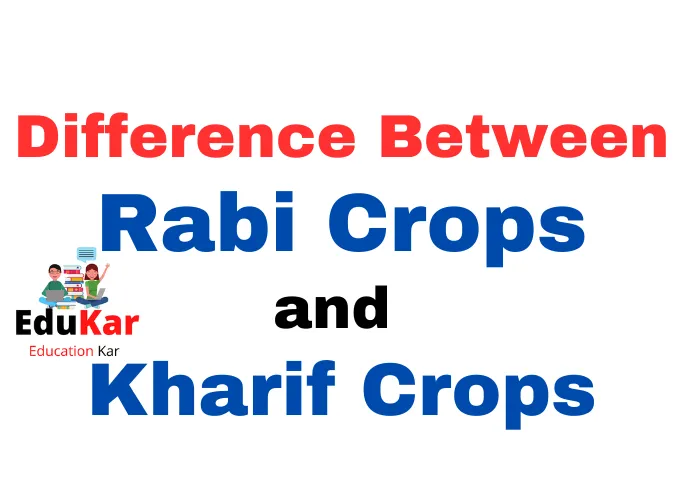Contents
Learn about the difference between Rabi and Kharif crops, their sowing season, climate requirements, and economic significance in India. Discover the major Rabi and Kharif crops, their cultivation, and how they contribute to food security and the economy. Get answers to frequently asked questions about Rabi and Kharif crops in this comprehensive blog.

Introduction
Agriculture is an essential part of our economy and society, and farming has been a way of life for many people throughout history. In order to maximize the yield of crops, it is important to understand the different types of crops and their requirements. Crops can be classified based on different criteria, and one of the most common classification is based on the season of their cultivation.
Understanding Crop classification
Crop classification is the process of categorizing crops based on their characteristics, and it is an essential part of agriculture. By classifying crops, farmers can make informed decisions about when and where to plant different crops, and how to manage them. There are different ways of classifying crops, but one of the most common is based on the season of cultivation. Crops can be classified into two main categories: Rabi and Kharif crops.
Rabi crops
Rabi crops are crops that are sown in winter and harvested in spring. They are called winter crops or dry crops because they are grown in the dry season. The sowing season for Rabi crops starts from October to December, and they are harvested in March to April. Rabi crops require a cool and dry climate, with a temperature range of 10-25 degrees Celsius. Some examples of Rabi crops are wheat, barley, mustard, peas, and gram.
Kharif crops
Kharif crops are crops that are sown in the rainy season and harvested in the autumn. They are called monsoon crops because they are grown during the rainy season. The sowing season for Kharif crops starts from June to July, and they are harvested in September to October. Kharif crops require a warm and humid climate, with a temperature range of 25-35 degrees Celsius. Some examples of Kharif crops are rice, maize, sorghum, cotton, and soybean.
Difference between Rabi and Kharif Crops
| S.No. | Rabi Crops | Kharif Crops |
|---|---|---|
| 1 | These crops are sown in the winter season, typically between October to December, and harvested in the spring season, typically between March to May. | These crops are sown in the monsoon season, typically between June to July, and harvested in the autumn season, typically between September to October. |
| 2 | Rabi crops require cool and dry weather conditions for germination and growth. | Kharif crops require warm and wet weather conditions for germination and growth. |
| 3 | Examples of Rabi crops include wheat, barley, mustard, peas, and gram. | Examples of Kharif crops include rice, maize, jowar, bajra, cotton, and sugarcane. |
| 4 | Rabi crops are grown in regions with a winter season, such as northern India. | Kharif crops are grown in regions with a monsoon season, such as southern and eastern India. |
| 5 | Rabi crops are typically irrigated crops, meaning they require additional water for growth. | Kharif crops can often rely on rainfall for irrigation, but may require additional watering during dry spells. |
| 6 | Rabi crops have a longer growing season and a slower rate of growth compared to Kharif crops. | Kharif crops have a shorter growing season and a faster rate of growth compared to Rabi crops. |
| 7 | Rabi crops can be planted after harvesting the Kharif crops, allowing farmers to maximize their crop yield in a single year. | Kharif crops are typically harvested before the planting of Rabi crops, limiting the potential for double cropping. |
| 8 | Rabi crops have a higher yield per acre compared to Kharif crops. | Kharif crops have a lower yield per acre compared to Rabi crops. |
| 9 | Rabi crops are generally considered to be less risky for farmers as they are less dependent on rainfall and have a longer growing season. | Kharif crops are generally considered to be riskier for farmers as they are heavily dependent on rainfall and are susceptible to flooding and other weather-related issues. |
| 10 | Rabi crops are often used for food and animal feed. | Kharif crops are often used for food, animal feed, and industrial purposes. |
| 11 | Rabi crops are generally easier to store and transport due to their dryness and hardiness. | Kharif crops are generally more susceptible to spoilage and damage during storage and transportation due to their higher moisture content. |
| 12 | Rabi crops are often grown in areas with irrigation facilities, which can be expensive for farmers. | Kharif crops are often grown in areas with natural irrigation such as rivers and canals, reducing the cost of irrigation for farmers. |
| 13 | Rabi crops have a lower demand in the market compared to Kharif crops, leading to lower prices for farmers. | Kharif crops have a higher demand in the market compared to Rabi crops, leading to higher prices for farmers. |
| 14 | Rabi crops are typically grown in regions with better soil quality and fertility due to a longer period of fallow land. | Kharif crops are typically grown in regions with lower soil quality and fertility due to continuous cropping and heavy rainfall. |
| 15 | Rabi crops have a higher requirement for fertilizer and nutrients compared to Kharif crops due to a longer growing season. | Kharif crops require less fertilizer and nutrients compared to Rabi crops. |
Conclusion
Understanding the differences between Rabi and Kharif crops is important for farmers, policymakers, and consumers. Rabi and Kharif crops have different requirements in terms of climate, water, and soil, and this affects the way they are cultivated and managed. Both Rabi and Kharif crops are important for the economy and food security of India, and their cultivation plays a vital role in the lives of millions of farmers across the country. By understanding the differences between Rabi and Kharif crops, farmers can make informed decisions about when and where to plant different crops, and consumers can better appreciate the importance of these crops in their daily lives.
FAQs:
What are Rabi crops?
Rabi crops are crops that are sown in the winter season and harvested in the spring. They are also known as winter crops or dry crops because they are grown during the dry season. Examples of Rabi crops include wheat, barley, mustard, peas, and gram.
What are Kharif crops?
Kharif crops are crops that are sown in the rainy season and harvested in the autumn. They are also known as monsoon crops because they are grown during the monsoon season. Examples of Kharif crops include rice, maize, sorghum, cotton, and soybean.
What is the difference between Rabi and Kharif crops?
The main difference between Rabi and Kharif crops is their sowing season. Rabi crops are sown in the winter season, while Kharif crops are sown in the rainy season. Rabi crops require a cool and dry climate, while Kharif crops require a warm and humid climate. Rabi crops are harvested in the spring, while Kharif crops are harvested in the autumn.
What is the climate requirement for Rabi crops?
Rabi crops require a cool and dry climate, with a temperature range of 10-25 degrees Celsius. They are sown in winter and require less water compared to Kharif crops.
What is the climate requirement for Kharif crops?
Kharif crops require a warm and humid climate, with a temperature range of 25-35 degrees Celsius. They are sown during the rainy season and require more water compared to Rabi crops.
What is the economic significance of Rabi and Kharif crops?
Rabi and Kharif crops are important for the economy of India. Rabi crops are mostly grown in the northern part of India, while Kharif crops are grown in the southern part of the country. Both Rabi and Kharif crops are important for food security and provide a source of income for farmers. Kharif crops also play a vital role in the production of oilseeds and cotton, which are important for the textile industry.









